Physical Address
304 North Cardinal St.
Dorchester Center, MA 02124
Physical Address
304 North Cardinal St.
Dorchester Center, MA 02124
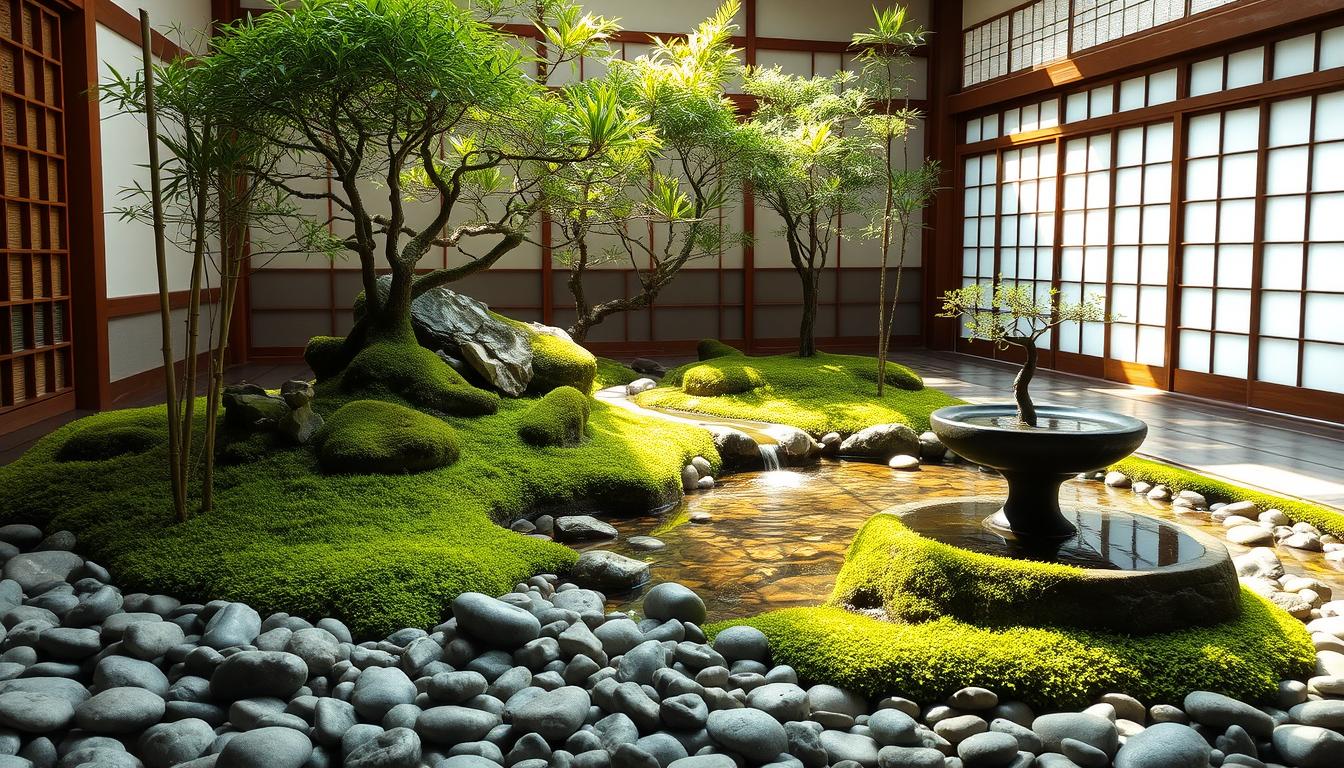
Imagine walking into your home to find a serene oasis. The stresses of the day just disappear. This peaceful place isn’t far away; it’s something you can create with an indoor Japanese garden. These gardens draw from long traditions, valuing harmony, simplicity, and the beauty of nature. They’re perfect for adding calm to your living space or making a quiet spot for deep relaxation. An indoor Japanese garden can offer you this serene escape.
Zen living spaces do more than just look good; they invite you to reconnect with nature and find inner balance. The sound of bamboo leaves and the sight of rocks and water help bring peace. For those caught up in today’s fast pace, having a part of your house as this peaceful haven is key to well-being.
We have put together 20 indoor Japanese garden ideas that use nature to create peace. These ideas use rocks, water, and plants in special ways to make a calm atmosphere. They’re designed to fit your space and are easy to care for. Imagine mossy grounds, little bonsai trees teaching patience, or a small pond that fills your home with calm. These ideas show that tranquility is more than just a thought. It can be a real part of your home.
Turning your inside areas into calming retreats is possible through miniature scenery. With items like bonsai trees and rock gardens, you can make peaceful places. These are not only lovely but also restful to our sense.
Bonsai trees do more than look pretty; they bring calmness and attentiveness. These small trees are carefully shaped and trimmed. They turn into living art that helps you feel relaxed and thoughtful.
Now, let’s look at some well-liked bonsai types:
Each kind has its special beauty, helping to create quiet places for relaxation.
Rock gardens use rock layouts and raked sand to show nature’s vast calmness. They are quiet places that show simplicity and beauty.
These are the design ideas often found in rock gardens:
Adding these designs inside can make a balanced and calm setting. It’s ideal for daily thought and peace.
Adding water features like ponds and waterfalls to your indoor Japanese garden boosts meditation. The sound of water flowing is calming. It lowers stress and increases inner peace. Let’s look at how indoor ponds and waterfalls can make your area peaceful.
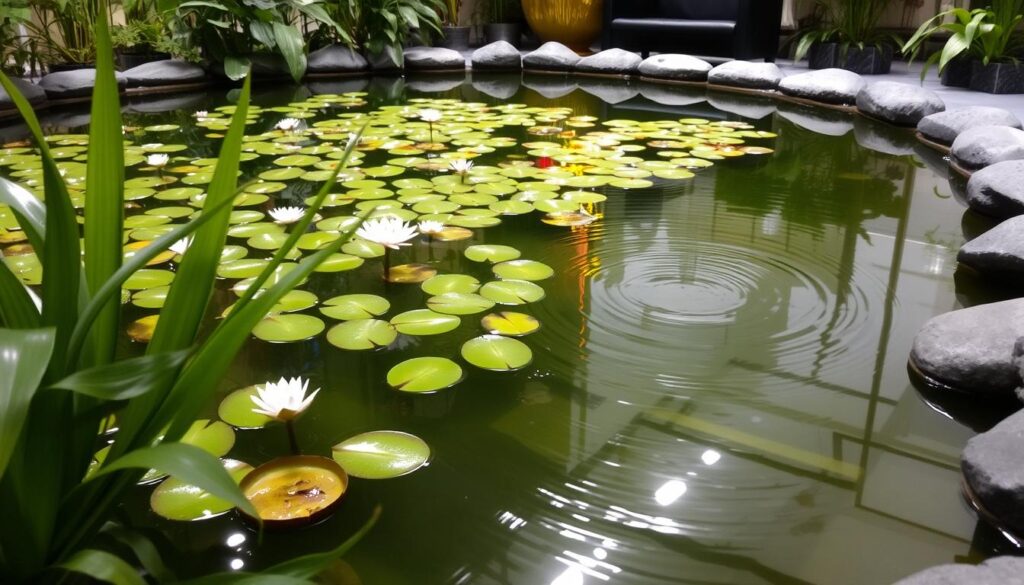
Small indoor ponds create a peaceful, nature-like setting indoors. They often have aquatic plants, increasing their natural charm. Adding floating lilies and colorful koi fish turns your indoor pond into a calming spot.
Indoor waterfalls add beauty to your tranquil area. Their gentle sounds are perfect for meditating. With soft lighting, they are not just beautiful. They also help you find peace of mind more easily.
Exploring Indoor Japanese Garden Ideas can make any living area a calm retreat. Whether you live in a small apartment or a big house, using Zen Interior Designs brings you closer to nature. This creates a peaceful indoor setting.
To start your own peaceful haven, consider these tips:
One favorite in Zen Interior Designs is bamboo. Its elegant look not only makes a space beautiful but also makes it peaceful. Adding soft moss puts in a natural softness and green.
Choosing plants for your Indoor Japanese Garden Ideas means picking ones that do well in shade, like ferns and mosses. Taking care of them with regular trimming and watering keeps your garden lively.
“The trend towards indoor zen gardens in the U.S. has been significantly influenced by the desire to connect the indoors with the outdoors.” — North American Japanese Garden Association
From DIY garden projects to expert displays, each idea mixes beauty and function. They invite you to build your own spot of quiet and harmony.
Adding natural elements to your indoor Japanese garden brings out its zen quality. The style is all about simplicity and nature, creating a peaceful space. Essential decor items can make your zen garden stand out.
Bamboo plays a key role in Japanese Decor for its strength and growth. It shows strength and growth when added to Zen Gardens. Its tall, thin stalks provide a calm, elegant look, adding structure. You can use potted bamboo or bamboo fencing to bring nature’s grace inside.
Moss is crucial for the zen garden’s calm feel. Its soft, green look makes indoors feel like a gentle nature spot. Moss is low-maintenance, fitting well in a peaceful, easy-care area. Use it to cover rocks or around bamboo for a quiet, thoughtful space.
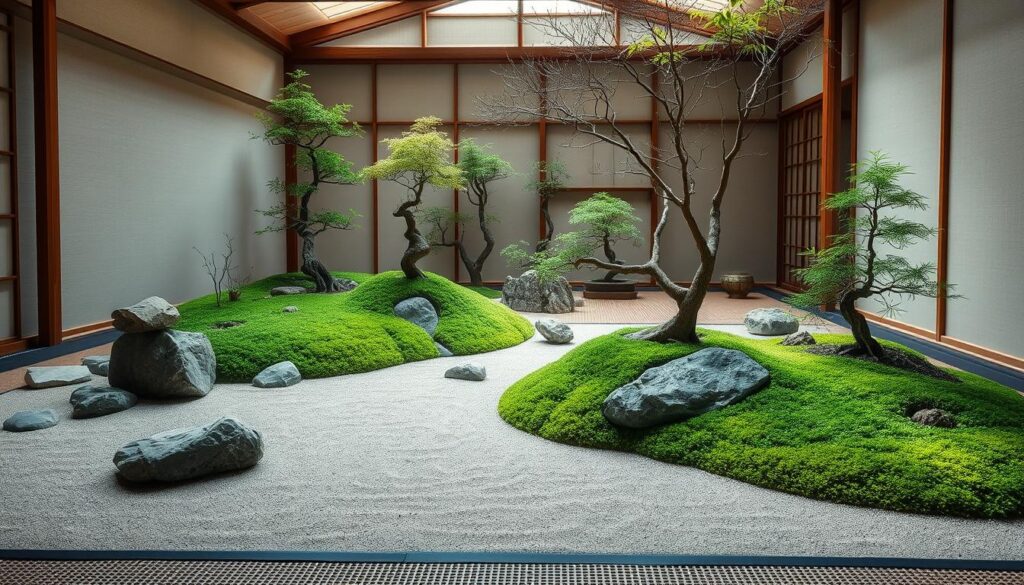
Adding plants to your indoor Japanese garden can be easy, even if you’re always on the go. It’s important to choose the right low-maintenance plants. This ensures your zen garden looks great and is easy to look after.
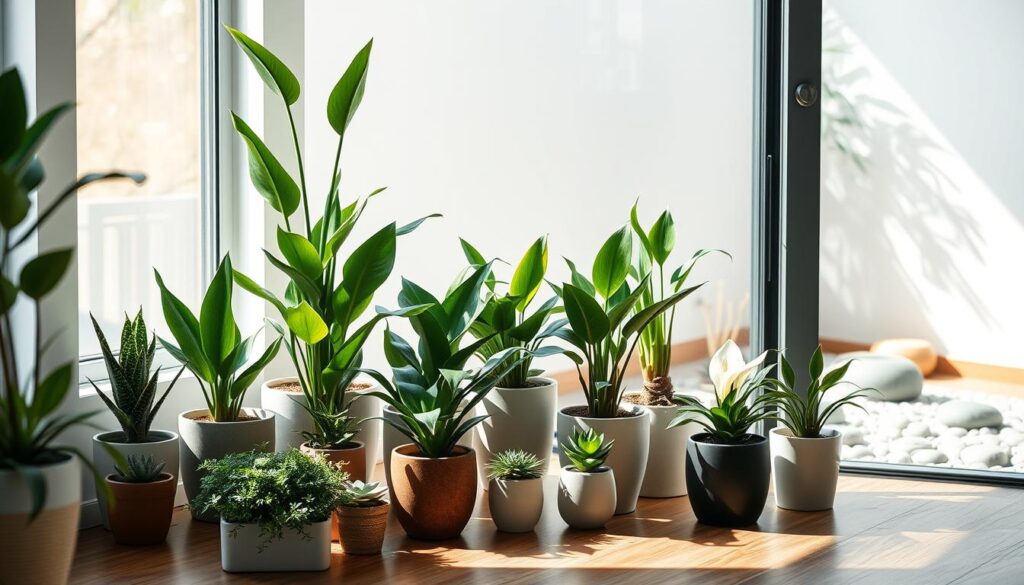
For indoor plants, choose tough ones like snake plants, spider plants, and philodendrons. They don’t need much care, perfect for a busy life. Snake plants do well in low light and don’t need much water. Philodendrons bring a lush look, even if you sometimes forget to water them.
Putting plants in the right spots is key to a beautiful and serene indoor garden. Place them where they get natural light. This boosts their growth and the beauty of your space. For example:
With these easy-care plants in the right places, you get a stunning and soothing space. It’s a perfect mix of beauty and low maintenance. Enjoy your indoor Japanese garden’s peaceful vibe without worrying about upkeep.
Making your outdoor and indoor spaces connect well is key to a calm environment. By smartly bringing outdoor elements inside and picking the right ones for indoors, you can create amazing Indoor Zen Garden Transitions. Here, we’ll share easy tips for merging outdoor beauty with indoor ease.
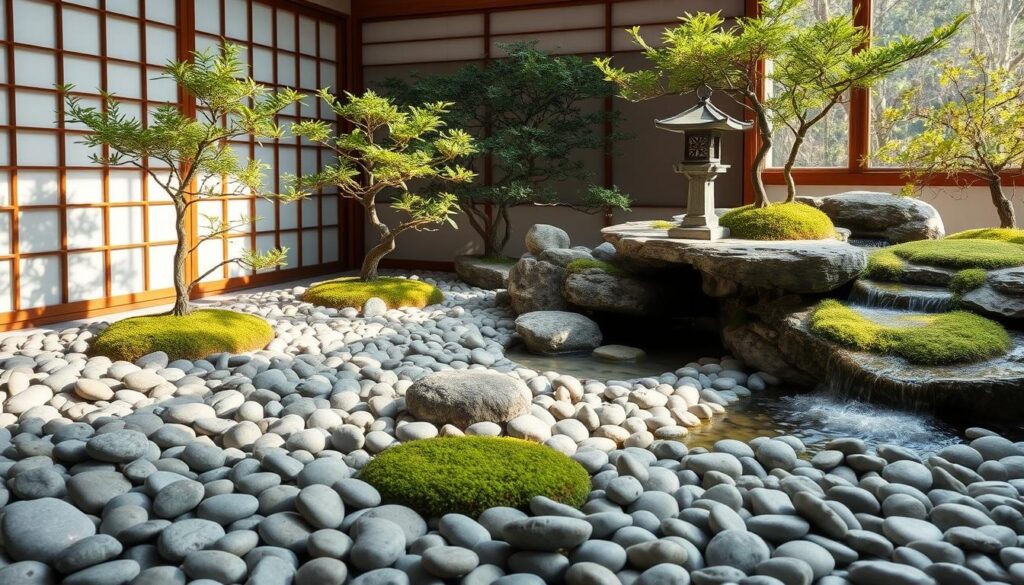
2. Mindful Use of Containers
3. Incorporate Symbolic Elements
Outdoor to Indoor Zen Garden Transitions need a careful mix of keeping outdoor elements and choosing new ones for indoors. So let’s invite nature’s calm into our homes and workspaces. This way, we can turn them into places of quiet.
Bringing the outside in demands a keen eye and choosing the right things. Let’s start this adventure to mix outdoor charm with indoor comfort. Our goal is a living space that’s always peaceful and inspiring.
Creating a Modern Zen Garden means using minimalist ideas for simplicity and space. We mix natural things in interiors, hitting a balanced mix. This mix invites calmness and deep thinking.
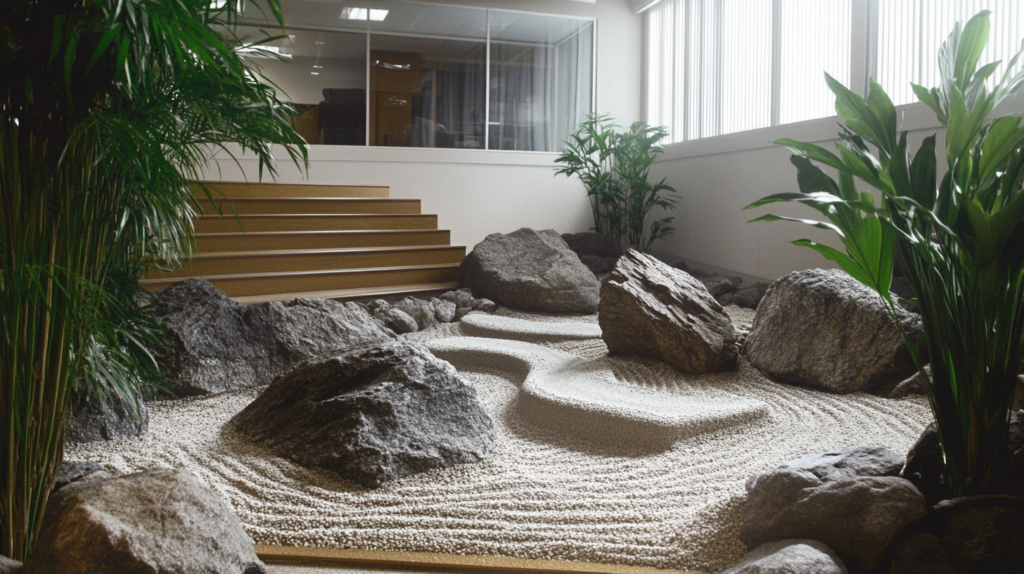
Minimalist garden design cuts clutter and focuses on what’s essential. Using clean lines and natural stuff like wood and stone is key. This method lets us find peace and clear thoughts by removing the unnecessary.
Adding natural elements and using wood, stone, and plants makes your garden feel meditative. Clean lines shape the space, making it organized yet calm. Consider these ideas:
“Clean lines and the strategic placement of stones and plants can transform your space into a sanctuary of simplicity and peace.”
When you blend these elements carefully, your Modern Zen Garden becomes beautiful and soothing. It’s a peaceful escape from daily life.
Turn your small area into a peaceful getaway with a Small Space Zen Garden. Use creative ideas like Vertical Gardening to bring calm to tight spots. We’ll look at smart ways to create your Compact Japanese Garden.
A great trick for Small Space Zen Gardens is using up vertical areas. Put planters on walls or try suspended gardens to add levels. This method uses small spaces well and brings layers of green inside. You could add:
These strategies let you mix different plants, moss, and small bonsai. They capture Japanese beauty and use space wisely.
For tiny areas, a Compact Japanese Garden is a serene spot. Aim for simplicity and balance for harmony. Consider these points:
Place each piece thoughtfully for a calm vibe. Rocks can symbolize magical places; sand can mimic rivers. These details make small areas into beautiful Zen places.
The tradition of Rock Gardens started in the Muromachi period (1336-1573). It is a key part of Zen Buddhism. Places like Ginkaku-ji, the Silver Pavilion, show how nature and spirituality connect deeply. Adding these elements to your indoor garden can make it a peaceful space for meditation.
Symbolic rocks in Zen gardens are very important. They stand for natural and spiritual aspects, designed to look like mountains or islands. For example, in Kyoto’s Ryoan-ji garden, rocks on white gravel symbolize harmony. They create a peaceful place for meditation, whether they represent Mount Fuji or Mount Horai.
Raking sand around symbolic rocks is a form of meditation. Drawing patterns in the sand is like mimicking water and shows the gardener’s thoughts. It helps bring about peace of mind. Places like Tōfuku-ji, redesigned by Shigemori Mirei, have beautiful sand patterns. They are not only nice to look at but also lift the spirit. Adding these practices to your indoor garden makes it a serene escape.
Adding Zen Garden Aesthetics to your home creates a calm and mindful space. Start by embracing Japanese Garden Design principles like austerity, simplicity, naturalness, and asymmetry. These principles help create a serene environment.
When integrating Home Integration, picking the right containers is key. Tall pots look great but shorter pots are better for easy care and saving space. Use plants such as azaleas, sedges, bamboo, ferns, mosses, and creeping ground covers. Bonsai trees, like ficus and juniper, bring beauty and elegance.
To make your Zen space calming, add plants that boost relaxation. Lavender, rosemary, chrysanthemum, snake plant, and jasmine are great choices. They grow well indoors and help with tranquility.
For Zen Garden Aesthetics care, water, prune, weed, fertilize, and keep plants at a uniform height regularly. This maintains harmony and balance.
Pick a spot in your home that’s well-aired, bright, and quiet. It boosts your Japanese Zen Garden Design’s peaceful feel.
Dōgen, the 13th-century founder of the Soto school of Zen, sees Zen as an active practice. It’s about being mindful of now without wanting, seeking, or holding on to anything.
Meditation nooks turn any home corner into a peaceful escape. They bring the calm of Japanese Zen gardens inside. This creates a place for relaxation and mindfulness.
Choosing the right spot for your meditation nook is crucial. Look for areas with little noise and plenty of natural light. These settings help create a soothing atmosphere.
Adding elements like tatami mats, shoji screens, and natural wood can make it feel more serene. They help your space feel like a true personal retreat.
For a welcoming meditation nook, comfy seating is a must. You can pick from cozy cushions, ergonomic chairs, or a zafu and zabuton set. Comfy seats help you meditate without discomfort.
They make your meditation space a sanctuary of peace and quiet. It becomes a spot where you can truly relax and find tranquility.
Transforming your indoor Japanese garden into a serene haven is easier with the right lighting. Using Tranquil Lighting can greatly improve your zen space. It creates a place of calm and relaxation.
Ambient Lights help make a peaceful setting. They give a soft glow that lights up your garden gently. Lanterns, paper lamps, or string lights can add a cozy luminosity.
Add dimmable lights to change the light level to fit the time of day or mood. The calming effect of these lights is better with natural materials like bamboo or rattan shades.
Feature Highlighting is also powerful. It brings focus to special parts like bonsai trees or water features. Small spotlights create compelling contrasts and shadows, adding depth.
LED lights hidden in the garden softly highlight features without harming the visual peace. This approach keeps your zen garden tranquil by spotlighting important parts while keeping a calm mood.
“A well-lit garden is not just about brightness but about using light to create an experience of depth, warmth, and tranquility.”
By using Tranquil Lighting and Feature Highlighting, your garden becomes a perfect spot for quiet and reflection.
Pathways in a Zen garden are not just for walking. They’re a spiritual journey. Creating Zen Garden Paths invites visitors to reflect and find peace. It’s about moving through the garden with mindfulness.
Stepping stones, or ishi-datami, guide visitors on Zen Garden Paths. They offer a way to deeply connect with the tranquility of the garden. Stepping Stones blend naturally with the garden, enhancing the journey. They can be irregular or uniformly cut, each offering a different experience.
When planning Pathway Designs, think about materials and designs that create harmony. Popular options include:
The skill in making Zen Garden Paths is in the mix of beauty and use. Whether it’s wood, pebbles, or concrete stones, the path should lead to tranquility. Keep these ideas in mind, and your garden will become a calm sanctuary.
Creating a Patio Zen Garden blends indoor and outdoor living. It makes your home’s vibe better. Let’s look at ideas to make indoor and outdoor feel like one.
A Patio Zen Garden helps indoor and outdoor spaces merge smoothly. Sliding glass doors or big windows can mix the areas. They let in light, making the space calm. Matching materials for both indoor and outdoor can also connect the spaces. For example, using the same flooring inside and out makes them look like one.
Add stone, water, and plants inside and outside for a Zen feel. Stone paths with Japanese lanterns can link your living room and patio. A bamboo water fountain brings relaxing water sounds. Also, Japanese maple trees in pots make indoor and outdoor spaces flow together.
Japanese Zen gardens are more than just pretty spaces. They help us feel peaceful and relaxed. With rocks, sand, and few plants, they are perfect for meditation. They clear our minds and offer a quiet place to rest.
When you make a Zen garden, you create a special place for calm and focus. Start with a rectangular space and fill it with sand or gravel. Raking around rocks or plants helps you meditate. This activity is soothing and helps clear your mind. Plants like Cryptomeria and Japanese maples make the garden beautiful all year.
Accessories like Buddha statues and stone lanterns make Zen gardens special. They’re not just beautiful. They’re places for deep thought and peace. People find that these gardens help with stress and focus. They’re perfect for quiet activities like studying. In today’s busy world, a Zen garden at home is a peaceful escape.